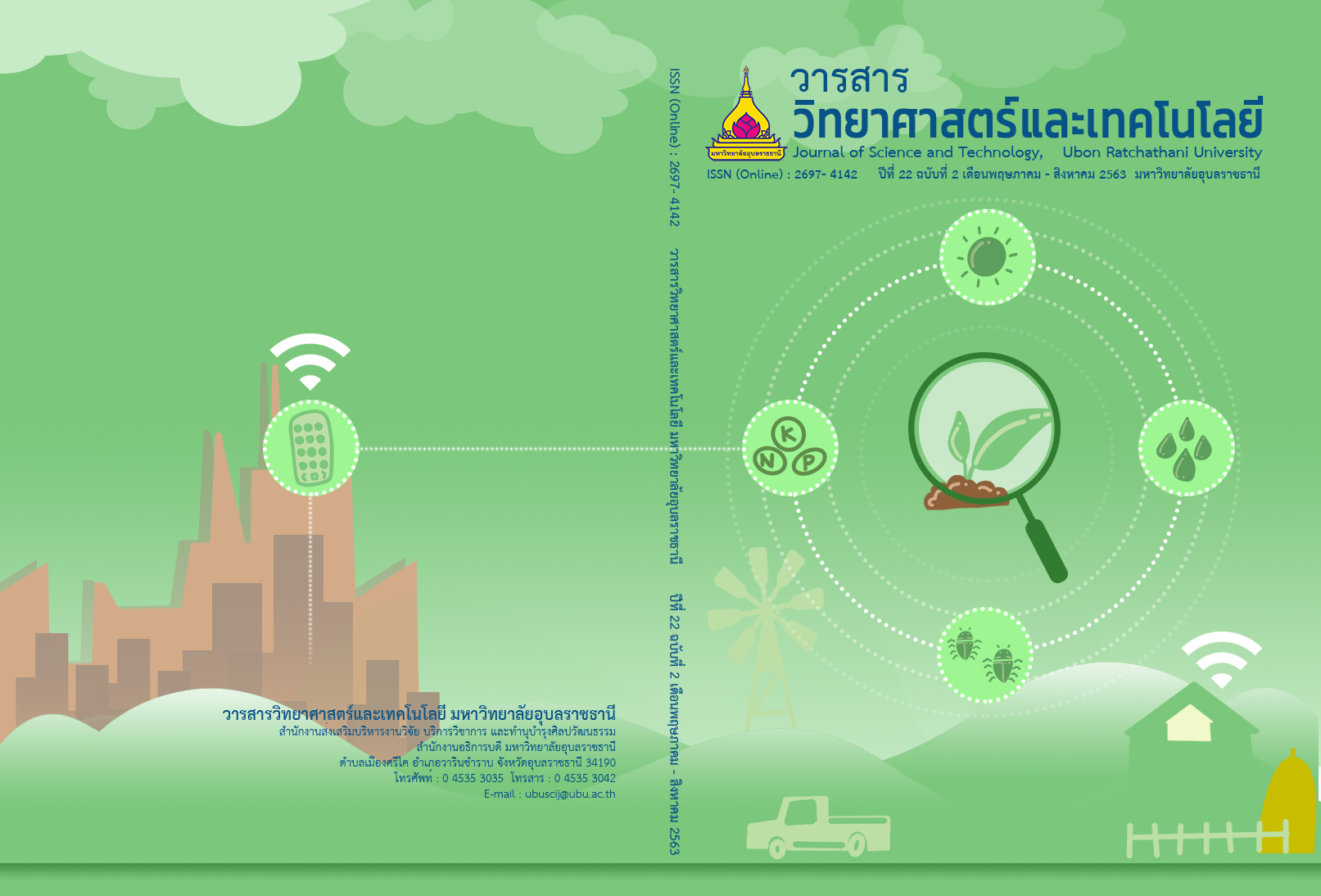รูปแบบการใช้น้ำจากสระเก็บน้ำผิวดินเพื่อการผลิตอ้อย: กรณีศึกษาอ้อยแปลงใหญ่ในจังหวัดสุรินทร์
Main Article Content
บทคัดย่อ
การศึกษารูปแบบการบริหารจัดการน้ำชลประทานให้แก่อ้อย โดยใช้แหล่งน้ำจากสระเก็บน้ำในพื้นที่ ประกอบด้วย 3 ขั้นตอนหลัก คือ (1) ประมาณความต้องการน้ำชลประทานของอ้อย (2) ประมาณปริมาณน้ำผิวดินจากสระน้ำด้วยวิธีสมดุลของน้ำของสระน้ำ (3) การจำลองเหตุการณ์เมื่อมีการใช้น้ำจากสระน้ำกรณีต่าง ๆ โดยแบ่งความไม่แน่นอนของฝนออกเป็น 3 รูปแบบ คือ ปีฝนน้อย ปีฝนปานกลาง และปีฝนมาก และมีรูปแบบการปลูกที่แตกต่างกัน 6 รูปแบบคือ อ้อยปลูกเดือนตุลาคม อ้อยตอเดือนธันวาคม มกราคม กุมภาพันธ์ มีนาคม และเมษายน ที่สอดคล้องกับช่วงเวลาการหีบอ้อยของโรงงานน้ำตาล จึงจำลองเหตุการณ์ได้ทั้งหมด 18 กรณี ผลการคำนวณความต้องการน้ำชลประทานของอ้อย ตลอดช่วงระยะเวลาปลูกเท่ากันที่ 10 เดือน และการจำลองเหตุการณ์พบว่า กรณีอ้อยปลูกเดือนตุลาคม มีการความต้องการใช้น้ำชลประทานมากกว่าทุกกรณี คือ ในปีฝนน้อย ปีฝนปานกลาง และปีฝนมาก ต้องการน้ำชลประทาน 725 714 และ 688 มิลลิเมตรต่อไร่ น้ำจากสระน้ำเพียงพอสำหรับพื้นที่ปลูกอ้อยน้อยกว่าทุกกรณี ขนาด 35 40 และ 65 ไร่ ตามลำดับ กรณีอ้อยตอ เดือนมีนาคมมีความต้องการใช้น้ำชลประทานน้อยที่สุด คือ ในปีฝนน้อย ปีฝนปานกลาง และปีฝนมาก ต้องการน้ำชลประทาน 199 179 และ 158 มิลลิเมตรต่อไร่ น้ำจากสระน้ำเพียงพอสำหรับพื้นที่ปลูกอ้อยมากกว่าทุกกรณีขนาด 175 285 และ 350 ไร่ ตามลำดับ ผลการศึกษานี้เป็นแนวทางการบริหารจัดการ การให้น้ำชลประทานแก่อ้อยได้อย่างเหมาะสม มีความสอดคล้องกันระหว่างรูปแบบการปลูก และความไม่แน่นอนของฝน
Article Details
บทความที่ได้รับการตีพิมพ์เป็นลิขสิทธิ์ของ วารสารวิทยาศาสตร์และเทคโนโลยี มหาวิทยาลัยอุบลราชธานี
ข้อความที่ปรากฏในบทความแต่ละเรื่องในวารสารวิชาการเล่มนี้เป็นความคิดเห็นส่วนตัวของผู้เขียนแต่ละท่านไม่เกี่ยวข้องกับมหาวิทยาลัยอุบลราชธานี และคณาจารย์ท่านอื่นๆในมหาวิทยาลัยฯ แต่อย่างใด ความรับผิดชอบองค์ประกอบทั้งหมดของบทความแต่ละเรื่องเป็นของผู้เขียนแต่ละท่าน หากมีความผิดพลาดใดๆ ผู้เขียนแต่ละท่านจะรับผิดชอบบทความของตนเองแต่ผู้เดียว
เอกสารอ้างอิง
http://www.oae.go.th/assets/portals/1/files/ebook/2562/tradestat61.pdf. Accessed 19 October 2019. (in Thai)
[2] Office of Cane and Sugar Board. 2018. Report sugarcane planting area Production year 2018/19.
http://www.ocsb.go.th/upload/journal/fileupload/
923-9040.pdf. Accessed 19 October 2019. (in Thai)
[3] Wonprasaid, S. and Girdthai T. 2015. Soil and Water Management for Ratoon Yield Improvement of Sugarcane in The Northeast. Research report. Suranaree University of Technology. (in Thai)
[4] Rittima, A. 2018. Reservoir Systems and Operation
Planning, Mahidol University. (in Thai)
[5] Kaewkongka, T. 2006. The Comparison Study between Furrow and Drip Irrigation Systems for Sugarcane of Kamphaeng Saen Soil Series in Central Area. Research report. Agricultural Production Sciences Research and Development Office, Department of Agriculture. (in Thai)
[6] Puttha, P. and et al. 2017. Evaluation of groundwater requirement of groundwater development project for agriculture: a case study of Nong Boon Mak district, Nakhon Ratchasima province, The Journal of KMUTNB., 27(4), 631–642, (in Thai).
[7] Jothityangkoon, C. 2019. Hydrology for Engineer, Suranaree University of Technology Press (in Thai).
[8] Chow, V. T. and et al. 1988. Chapter 3 atmospheric water, in Applied Hydrology, McGraw-Hill, pp.53–98.
[9] Thong-a-raam, D. and et al. 2002. Design and technology of crop irrigation, 2nd edition, Mitrkaset marketing and advertising, LTD. (in Thai).
[10] Office of Water management and Hydrology. 2009. The Study of Runoff Coefficient and Relation between Mean Annual Runoff of 25 River Basins in Thailand, Royal irrigation department Thailand, Hydrology Report No.1516/09. (in Thai)


